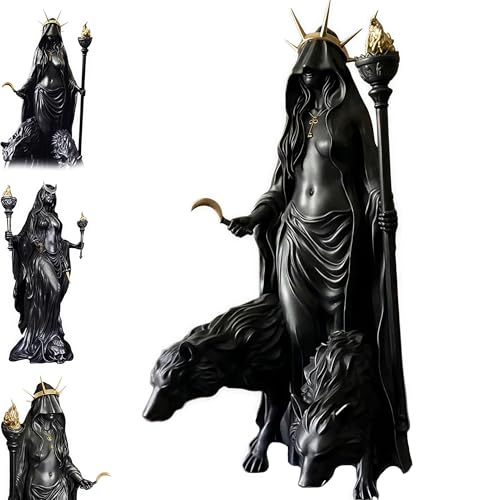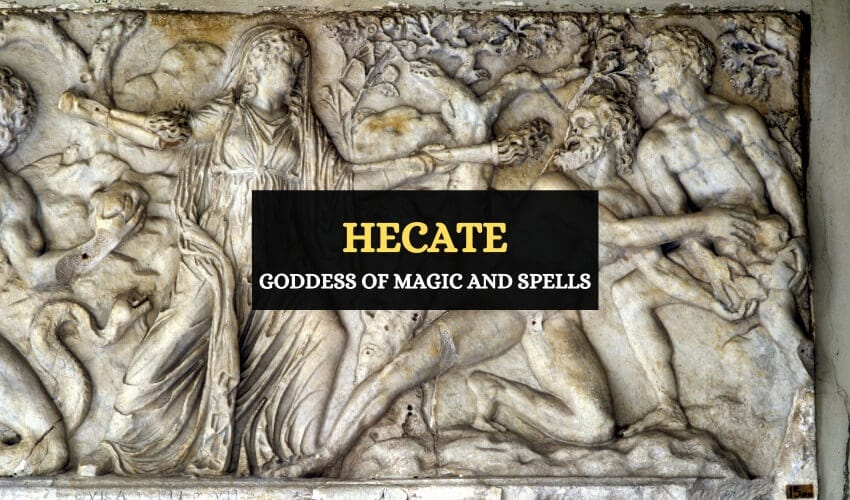
Table of Contents
With power over heaven, earth and sea, Hecate or Hekate, the goddess of witchcraft, magic, ghosts, necromancy, and the night, is an ambivalent being in Greek mythology. While often represented as evil, a close look into her story shows that she was associated with good things. It’s also important to consider context when discussing Hecate – the magic and spells she was connected with wasn’t considered evil in her time. Here’s a closer look at a complex goddess.
Hecate’s Origins
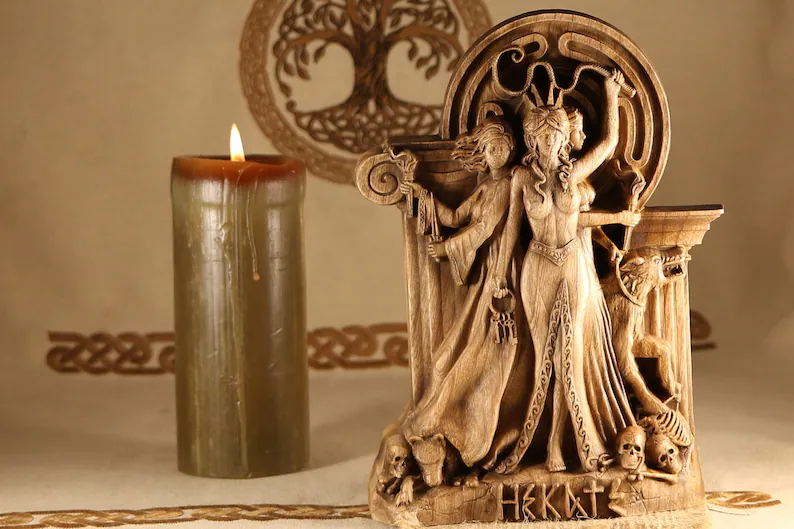
Although Hecate is known as a Greek goddess, her origins might be found a little farther to the east, in Asia Minor. It’s said that the first to worship her were the Carians in Anatolia. The Carians used theophoric names with the root Hekat- to invoke and adore the goddess of witchcraft. Discoveries suggest that the Carians had a cult site in Lagina, Asia Minor.
What this means is that Hecate was probably taken from Carian beliefs and imported into Greek mythology. Considering that the first mentions about Hecate in Greek myth comes relatively late, compared to other gods, it’s likely that she was simply copied.
Who is Hecate in Greek Mythology?
In Greek Mythology, Hecate’s family background is unclear, with sources citing different things.
Hecate is said to be the daughter of the Titans Perses and Asteria, and she was the only Titan to keep her power after the war between the Titans and the Olympian gods.
Some other sources state that she was the daughter of Zeus and Demeter, while others say that she was the daughter of Tartarus. According to Euripides, Leto, the mother of Artemis and Apollo, is her mother.
Hecate’s Involvement in Wars
Hecate was involved in the war of the Titans as well as in the war of the Gigantes. She was a pivotal figure in both wars and was respected by Zeus and the other gods.
- As Hesiod wrote in Theogony, after the war of the Titans, Zeus honored Hecate and gave her countless gifts. The gods did no harm to her, nor took anything away from what was already hers during the reign of the Titans. She was allowed to keep her powers over heaven, earth, and sea.
- When the Gigantes declared war on the gods under Gaia’s command, Hecate took part in the conflict and sided with the gods. She is said to have helped them defeat the giants. Vase paintings normally show the goddess battling, using her two torches as weapons.
Hecate’s Association with Demeter and Persephone
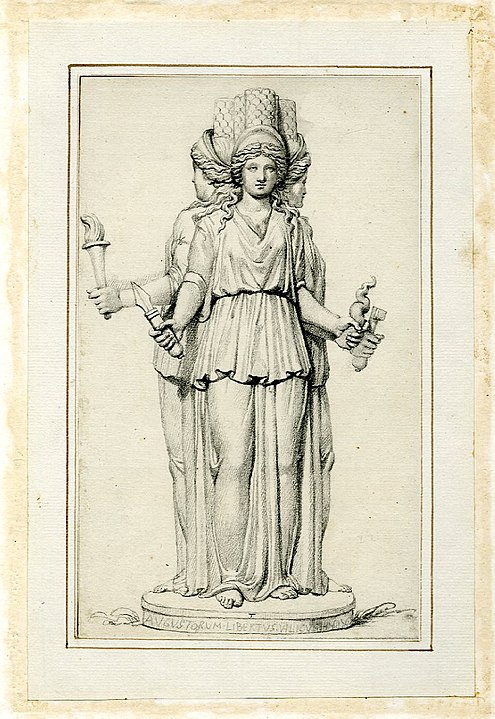
Several myths refer to the rape and kidnapping of Persephone, daughter of Demeter, perpetrated by Hades. Accordingly, Hades raped Persophone and took her with him to the underworld. As Hades seized her, Persephone cried for help, but no one heard the desperate attempts to escape. Only Hecate, from her cave, witnessed the abduction but was powerless to stop it.
Hecate assisted in the search for Persephone with her two torches. Some sources say that this task was requested either by Zeus or Demeter. Hecate took Demeter to Helios, the god of the sun, to ask for his help.
The search for Persephone also gave Hecate her association to crossroads and entrances and made the two torches her foremost symbol in mythology. In most of her statues she is depicted with her two torches, and in some is portrayed with triple form looking in all directions, to symbolize the crossroads.
After having found Persephone, Hecate stayed with her in the underworld as her companion. Some authors say that she was also Persephone’s guide in her yearly trips to and from the underworld.
The Dark Side of Hecate
Although Hecate was a goddess who tended to the good, her links to the night, necromancy and witchcraft show a darker side of her myth.
Besides the torches, Hecate is said to have been accompanied by a pack of blood-lusting hounds. Other sources have the Erinyes (the Furies) as Hecate’s companions. Hecate was a virgin goddess, but her daughters were the Empusae, female demons born out of witchcraft who seduced travelers.
Hecate is known for having a variety of underworld creatures who roam the world at her service.
Rituals and Sacrifices to Hecate
Hecate worshippers had a variety of atypical rituals and sacrifices to honor the goddess, which were performed every month during the new moon.
The Supper of Hecate was the ritual in which devotees offered her food at crossroads, road boundaries, and thresholds. The dishes were lit on fire with a small torch to ask for her protection.
Another ritual was to sacrifice dogs, normally puppies to adore the goddess. Sorcerers and other magic enthusiasts prayed to the goddess for her favor; she was also often invoked in curse tablets of antiquity.
Symbols of Hecate
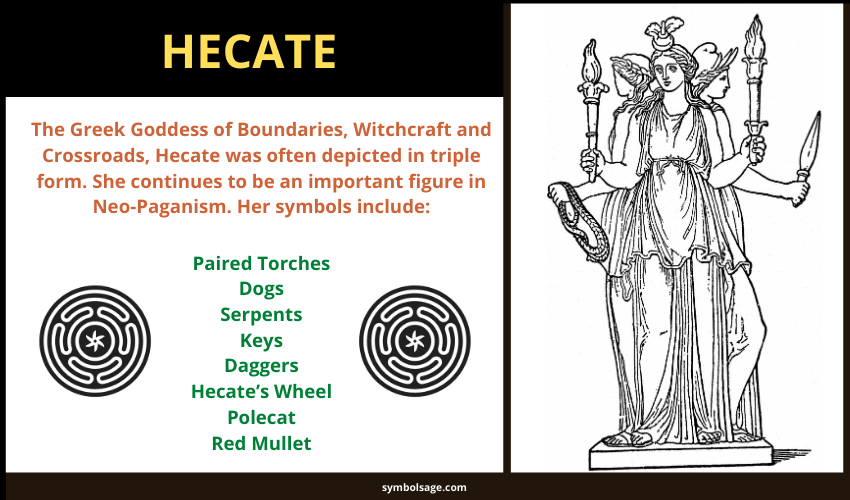
Hecate is often depicted with several symbols, typically depicted on pillars called Hecataea which were placed at crossroads and entrances to repel evil spirits. These pillars featured Hecate in three-person form, holding various symbols in her hands. Here are the most popular symbols associated with her:
- Paired torches – Hecate is almost always depicted with long torches in her hands. These symbolize her bringing light into a dark world.
- Dogs – Like Hecate, dogs also have positive and negative aspects, sometimes described as protectors and guardians, and at other times, as fearful and dangerous.
- Serpents – Hecate is sometimes shown holding a serpent. Serpents were believed to be connected to magic and necromancy, often used in these rituals to feel the presence of spirits.
- Keys – This is a rarer symbol associated with Hecate. These symbolize the keys to Hades, strengthening her association with the underworld.
- Daggers – Daggers are used to slaughter animals for sacrifices, to protect against evil spirits or to engage in rituals of magic. The dagger represents Hecate’s role as the goddess of witchcraft and magic.
- Hecate’s wheel – Hecate’s wheel features a circle with a maze with three sides. It symbolizes her triplicity as well as divine thought and rebirth.
- Crescent – This is a later symbol associated with Hecate, and dates from around the Roman times. She began to be seen increasingly as a lunar goddess, with the crescent representing this connection.
Writers such as Euripides, Homer, Sophocles, and Virgil all make references to Hecate. On certain vase paintings, she’s depicted with a knee-long dress and hunting boots, which resemble the image of Artemis.
In Macbeth, Hecate is the leader of the three witches, and appears before them to know why she’s been excluded from meetings with Macbeth.
Below is a list of the editor’s top picks featuring Hecate’s statues.
Hecate in Modern Times
Hecate continues to endure as a deity associated with the dark arts, magic and witchcraft. As such, she’s sometimes viewed as a sinister figure.
Since the 20th century, Hecate has become a symbol of the occult and witchcraft. She’s an important deity in Neopagan beliefs. She’s an important figure in Wiccan beliefs and is often identified with the Triple Goddess.
Her symbols, including the Hecate’s wheel and the crescent, are important pagan symbols even today.
To Sum up
Hecate continues to endure in modern culture and beliefs. She symbolizes both good and evil, with myths portraying her as kind and compassionate, and as a guardian and protector. Today, she’s associated with the dark arts and is viewed with wariness, but she remains an intriguing and somewhat mysterious figure of ancient Greek mythology.

